Tape for Countertop Sides to Make Refrigerator Moving Sliding Easy

Learn how to transform your bathroom or kitchen countertop with contact paper! You'll be amazed by how good it looks and how well it holds up over time!
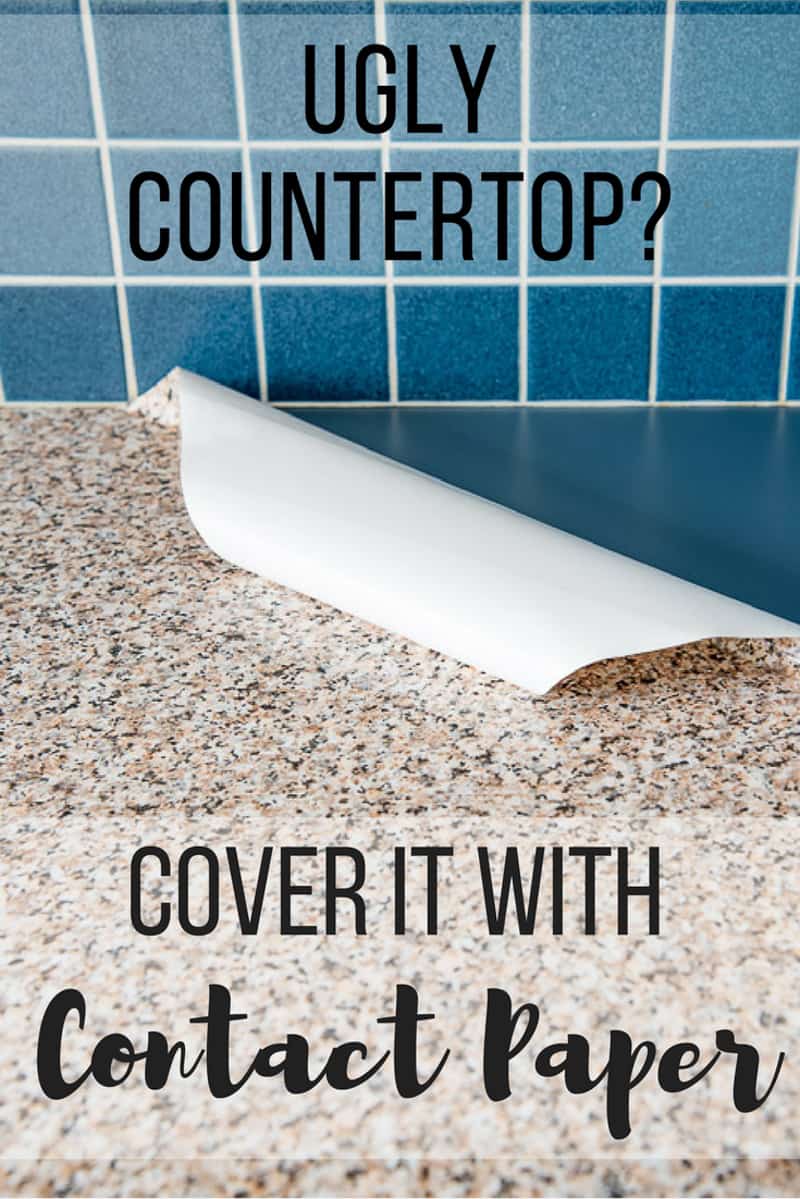
People thought I was crazy. There's no way contact paper will hold up in a kitchen, they said. Well, here we are two years later, and it's still going strong! Even with water, heat and everyday abuse, that contact paper countertop still looks amazing!
Watch the video below to see how easy it is to apply!
Subscribe to my YouTube channel for more DIY project videos like this one!
This post contains affiliate links for your convenience. Purchases made through these links may earn me a small commission at no additional cost to you. Please visit my disclosures page for more information.
I get a LOT of questions about my kitchen counter contact paper. How does it look now? Is the contact paper waterproof? Does it leave any sticky residue when you remove it? Does it really look like granite?
I'll answer all these questions, plus give you a little tour of my faux granite countertops, now that we've had them for over two years. I'll even remove the contact paper from one section, so you can see how the countertop underneath is holding up.
Contact paper comes on a roll, with a smooth, waterproof side and a sticky backing covered with a protective film. Basically, it's a giant countertop sticker!
Back in the day, this decorative material was used to line the inside of drawers and shelves. It prevents wet dishes from ruining the cabinetry, so why not use it as a countertop cover too?
Nowadays you can find contact paper in a broad range of colors and patterns. I used a granite pattern in my kitchen, but you can find everything from marble to wood grain to faux tile! You can find lots of creative ways to use contact paper around the home here!
I get this question ALL.THE.TIME! Here's the DC-Fix countertop contact paper I used in my kitchen, which you can find on Amazon. They now make a full countertop width roll, which I used in the video above.
There are lots of other color options available online! Look for the rolls with 26.5" widths for countertop depth, and purchase a little more than you need. Colors can differ between print runs, so it's better to hold on to the extra roll in case you need it down the road.
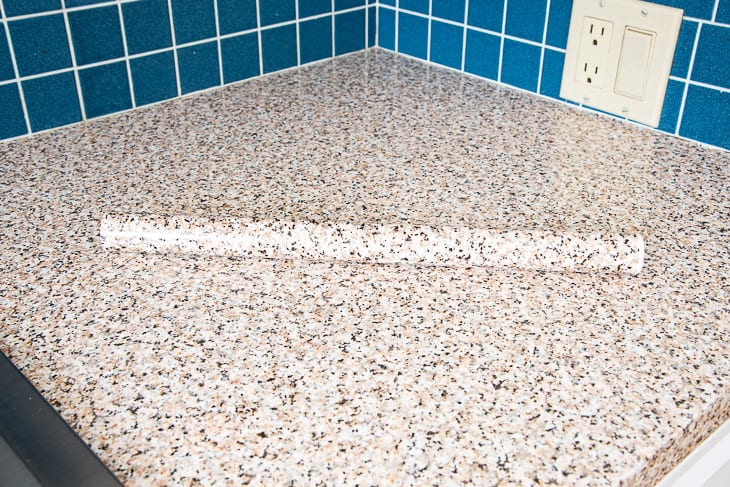
I've used different brands of contact paper for other projects around the house, but nothing holds up quite as well as the DC-Fix brand I used for the countertops. I tried dry erase contact paper on these cabinet doors for my workshop, frosted glass contact paper for windows, and this patterned contact paper for a room divider screen, but both tend to peel up at the corners over time.
Drawbacks
A comment I frequently get is that you can't cut on contact paper like real granite. Of course you can't! But we couldn't chop on the laminate countertop underneath either, so it was a non-issue for us. Plus, why are you dulling your good kitchen knives on granite anyway? That's what a cutting board is for!
Another issue that people love to point out is that the seams are visible where two pieces of contact paper meet. But if you choose a random pattern like this faux granite, the seams blend together and you really have to hunt for them!
Of course, these contact paper kitchen counters aren't permanent. We plan to completely gut and remodel our kitchen in a few years, and this quick fix lets us enjoy a nicer looking space while we save up for the big renovation.
If you're looking for a more permanent solution to your dated countertops, try adding a new layer of laminate! You can learn how to cut and install laminate sheets in this post.
Durability
Want to see how our contact paper kitchen countertop has held up over the past few years? Let's take a little tour and find out!
Over time
The oldest section is on this used kitchen cabinet I bought at an architectural salvage store. The attached countertop was in bad shape and didn't match the rest of the kitchen anyway, so I figured contact paper couldn't make it any worse! Once I saw the results, I knew I had to try it on the rest of the kitchen.
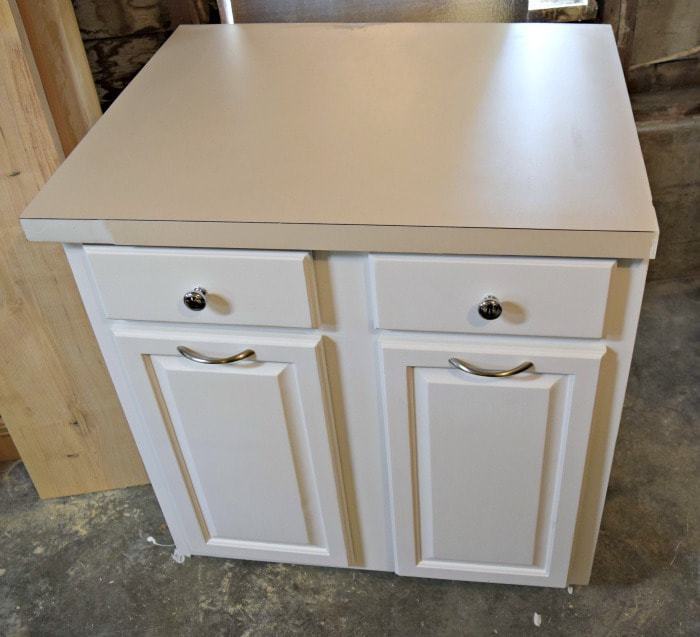
This empty space used to be where our fridge was, but we did a little shuffling when we closed up the back door. I turned the salvaged piece into a pull out trash can cabinet, and it gets a LOT of use every day.
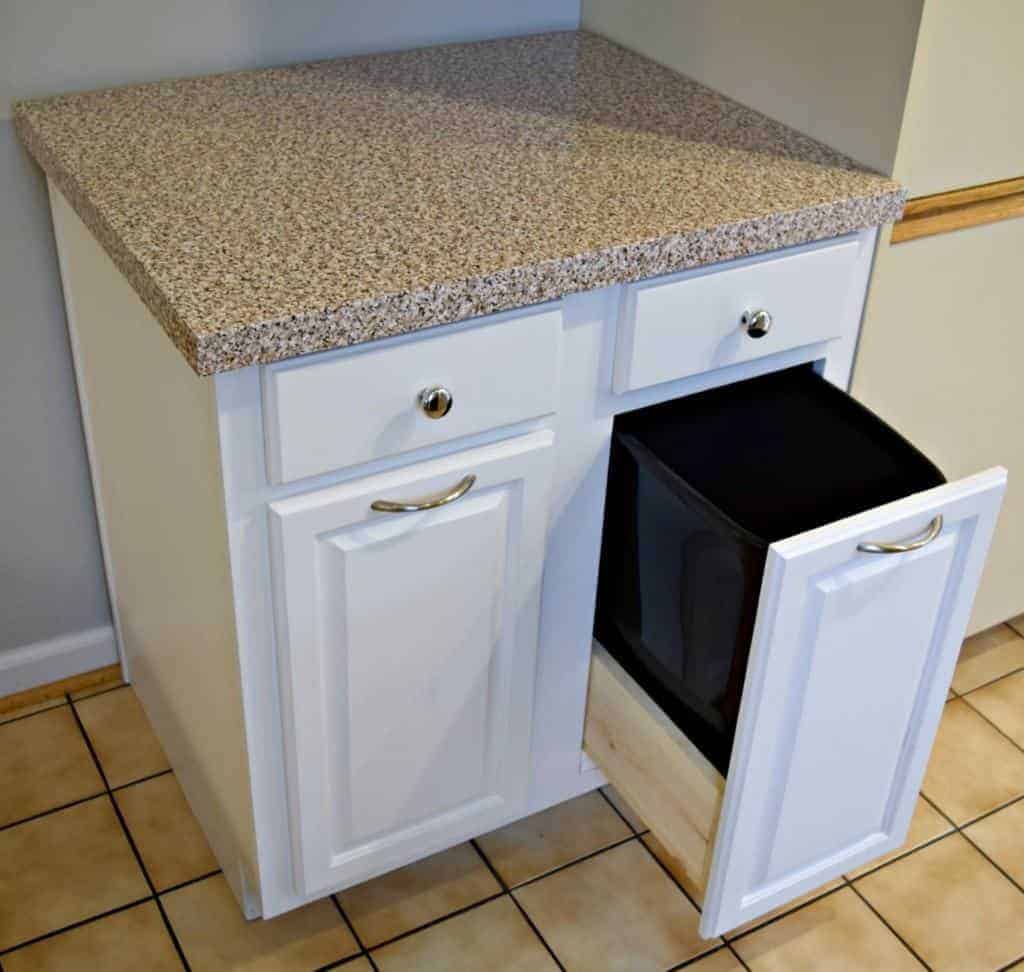
The top is mostly used for making school lunches, since that's where the bread box is. Crumbs get wiped off daily, but it's not in the main cooking or cleaning area. So how's this section of countertop contact paper holding up? Still looks like the day I applied it!
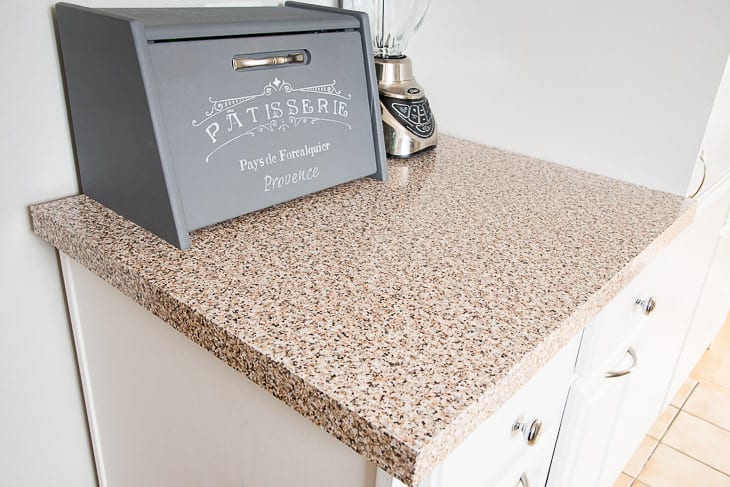
The outside corner, which gets rubbed up against frequently, has a tiny bit of wear. A quick touch up with a scrap of contact paper will fix that! The granite pattern blends in easily, so you can't see where repairs have been made.
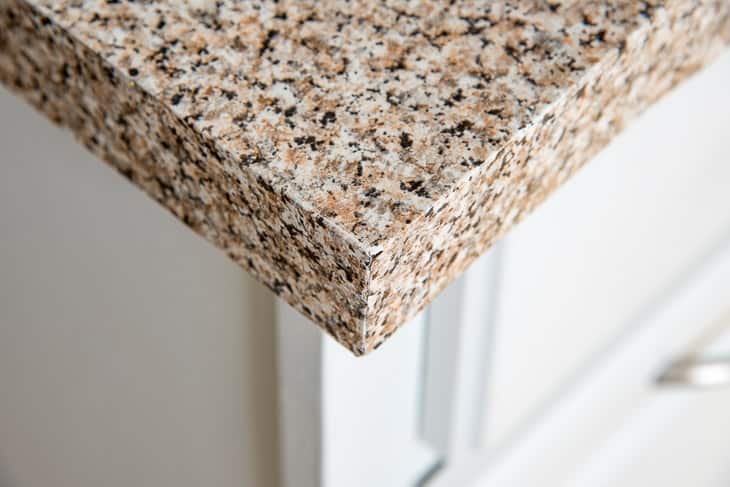
Next to the Stove
On to the more important question . . . how does the countertop contact paper hold up next to the stove? Pretty well, I'd say!
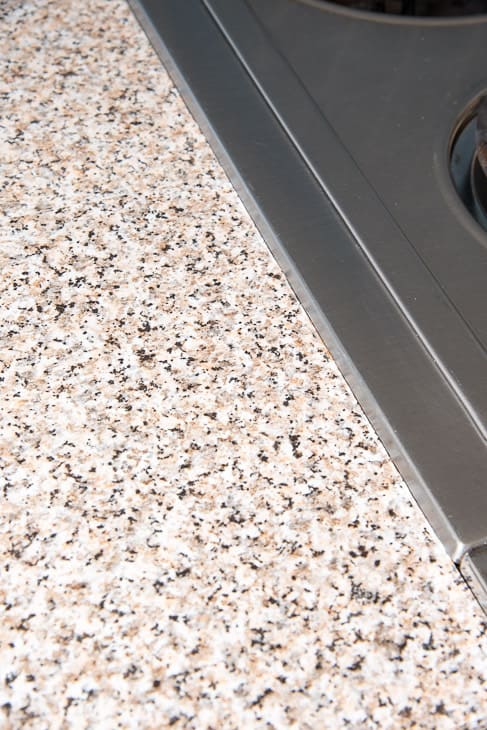
The only sign of wear I can find is in the area between the sink and the stove, where most of the cooking action happens. The seam between the two sheets of contact paper has lightened a bit from daily cleaning, but it's only really visible from this low angle.
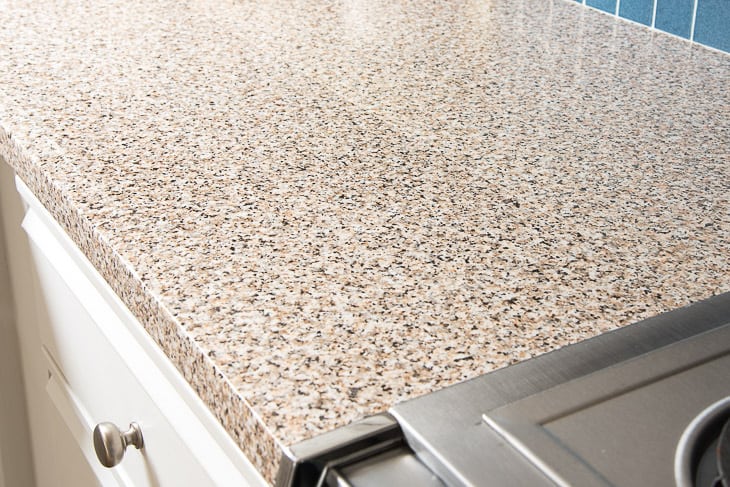
Want to avoid the seam down the middle? There are now counter width contact paper rolls that are made to do just that! These weren't available two years ago when I did this project, but I might end up replacing mine with the new 26" wide version for a flawless look.
Next to the Sink
So the countertop contact paper can handle the heat. What about water? Doesn't the adhesive turn into a gooey mess after a while? Or develop a haze of mold from constant water exposure? NOPE!
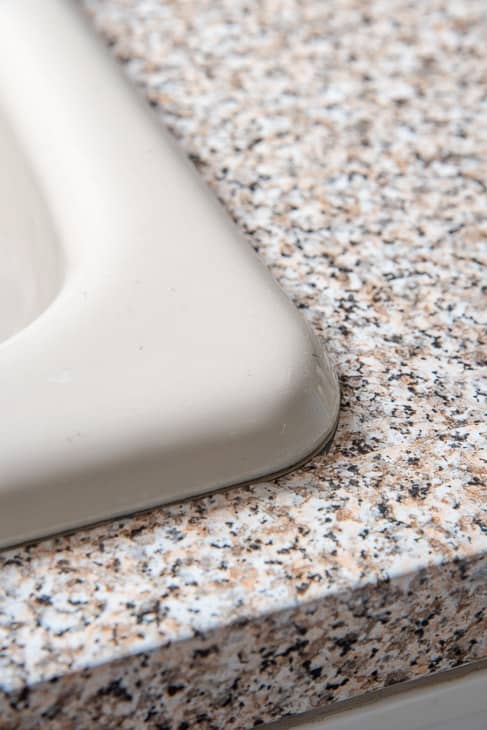
If you zoom in real close, you can see a tiny bit of the blue laminate peeking out from under the corner of the sink. But I think that's from when I originally cut the contact paper to fit the sink, not from any damage due to normal wear and tear. A little clear caulk would protect the seams even more!
Seriously, this area gets soaked when we're washing big pots and pans, and water pools just like on any other countertop material. It's thick and waterproof, so drips stay on the surface until you wipe them up.
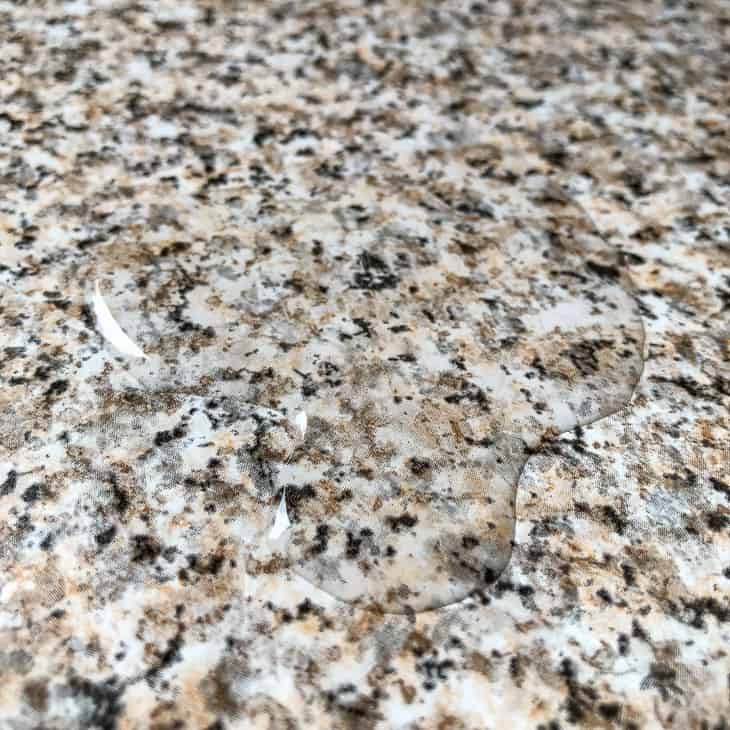
Ready to tackle your own kitchen or bathroom? Here's how to do it!
Clean the countertop
Give the entire surface of the countertop a good scrubbing with regular household cleaner. Don't forget the front edge and underneath! Allow everything to dry thoroughly before moving on to the next step.
Cut the contact paper to size
You don't have to get out the measuring tape or a ruler. Just roll out the contact paper so that it covers the entire area, including the edges, with an extra inch or two at the ends.
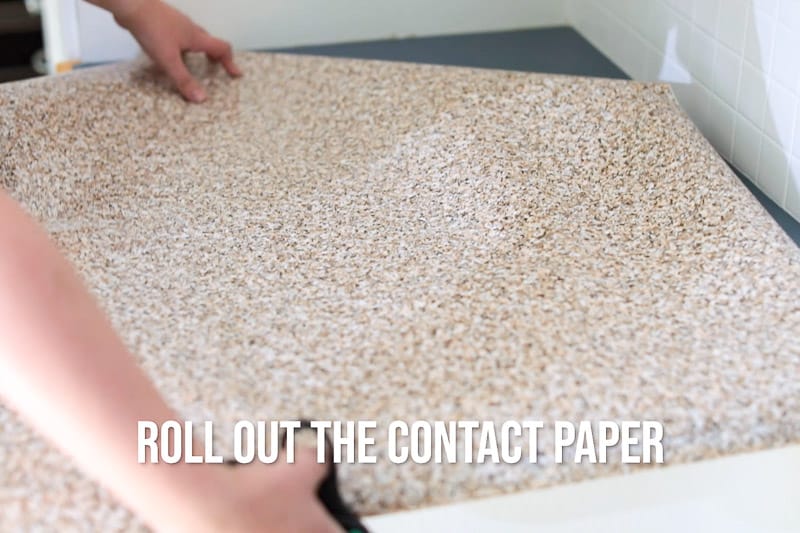
Cut off the excess paper with scissors. You can use the lines on the back to help get a straight cut, but I just eyeballed it with the edge of the roll as a guide.
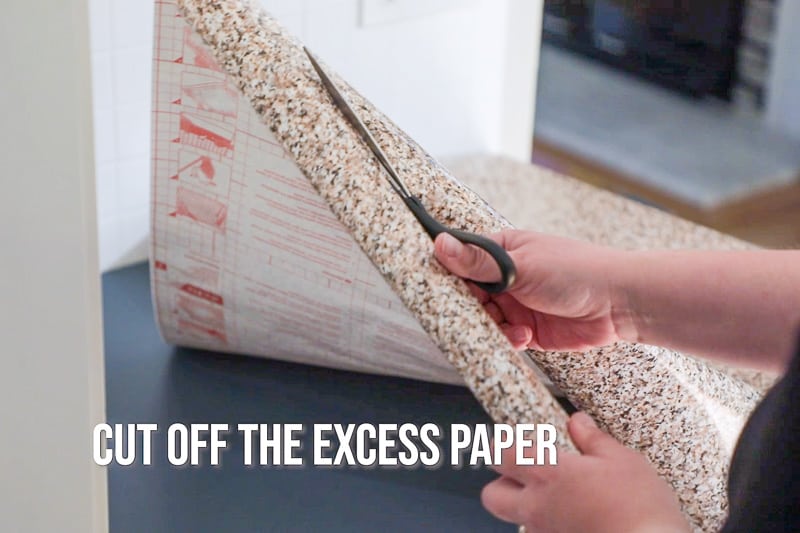
Spray the counter with Windex (optional)
I learned this trick from a reader! She suggest lightly spraying the countertop with Windex before applying the contact paper to allow it to slip and slide on the surface easily. Once you have it in place, use a squeegee to push out the moisture underneath! I've also heard that soapy water works the same way, but the alcohol in the Windex will evaporate faster.
I used this technique with translucent contact paper on the window after I finished this half bath remodel, and it worked great! I think it would be even easier on a horizontal surface like a countertop, so the moisture doesn't drip while you're working. I ended up with quite a puddle on the windowsill!
Line up the edge with a corner
Start in a back corner, where you can line up the long edge of the paper with the back wall. Leave a little overhang on the end so you can trim it to an exact fit later.
Peel the paper backing away about 6 inches, and stick it down. Run a smoothing tool (you could also use a credit card) over the entire area to adhere it firmly to the surface. Push out any air bubbles towards the edge.
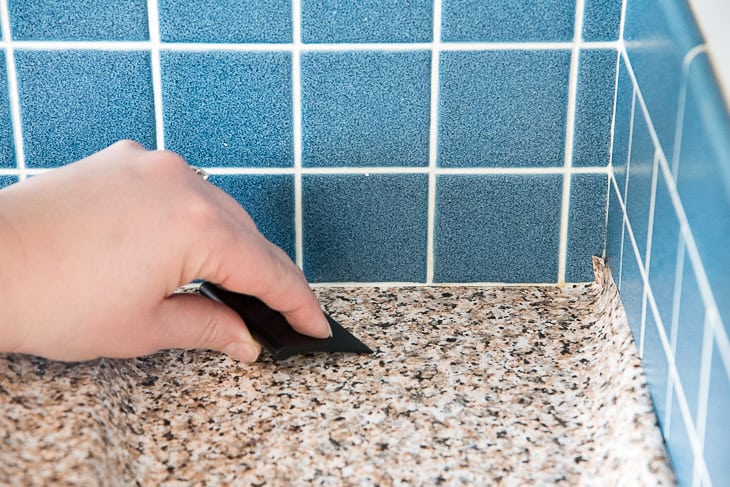
Pull off backing and smooth out air bubbles
Continue removing the backing from underneath, pressing the contact paper down as you go. Pulling the roll taut with one hand and sliding the smoothing tool towards the roll helps prevent air bubbles from forming.
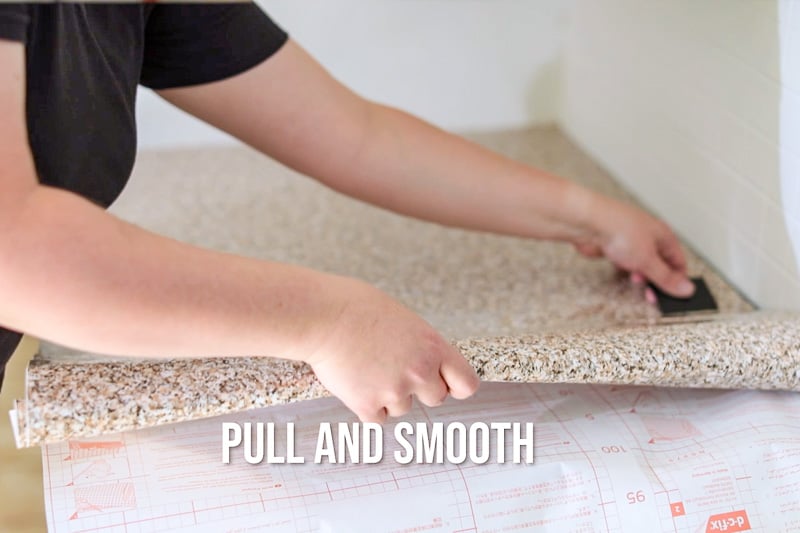
If you veer off track or get some bigger air bubbles, just pull up the contact paper and try again! Smaller air bubbles can be popped with a pin and pressed down later.
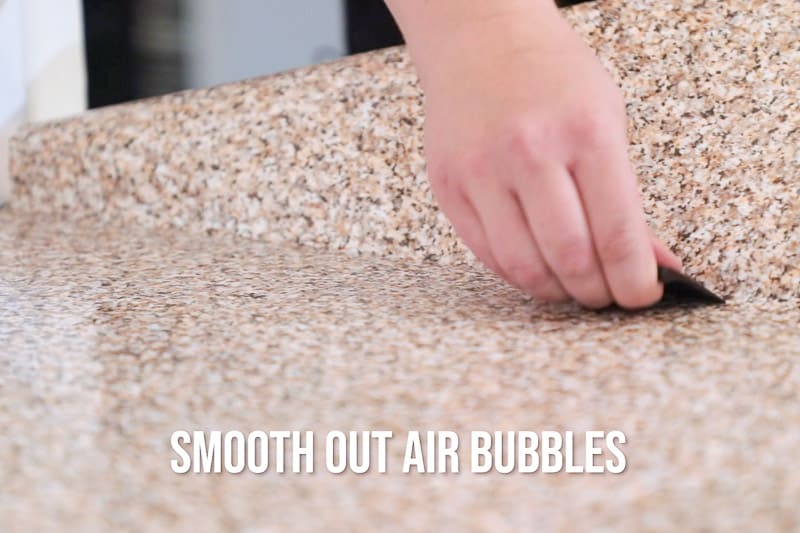
Leave the excess hanging over the outside edge for now. The corners can be a bit difficult, but I have a few tricks to make it look great!
Trim off excess and touch up gaps
Press the inside corner tight against the wall with the smoothing tool and run a utility knife down the edge to trim off the excess. Repeat this process for the underside of the countertop where it meets the cabinets.
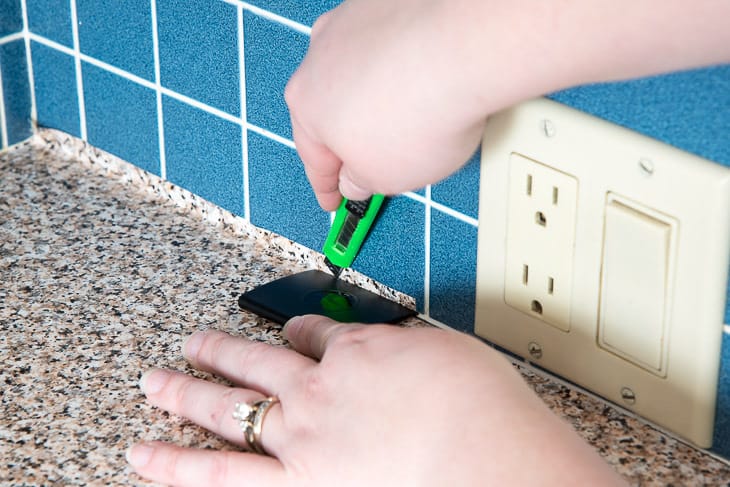
I veered off track a bit with the wider countertop depth contact paper, so there was a gap between the backsplash and the paper. Luckily, that's easy to fix!
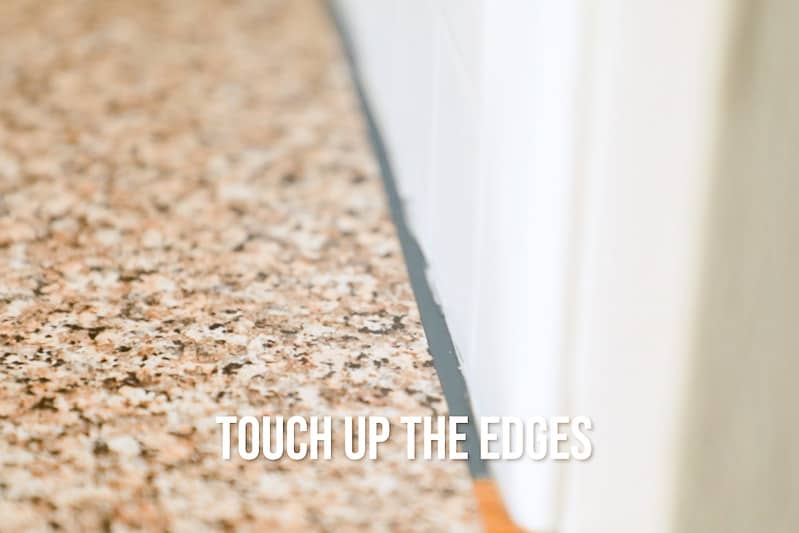
Cut a thin strip from the roll of contact paper, slightly wider and longer than the gap. Use the factory cut edge for the best results.
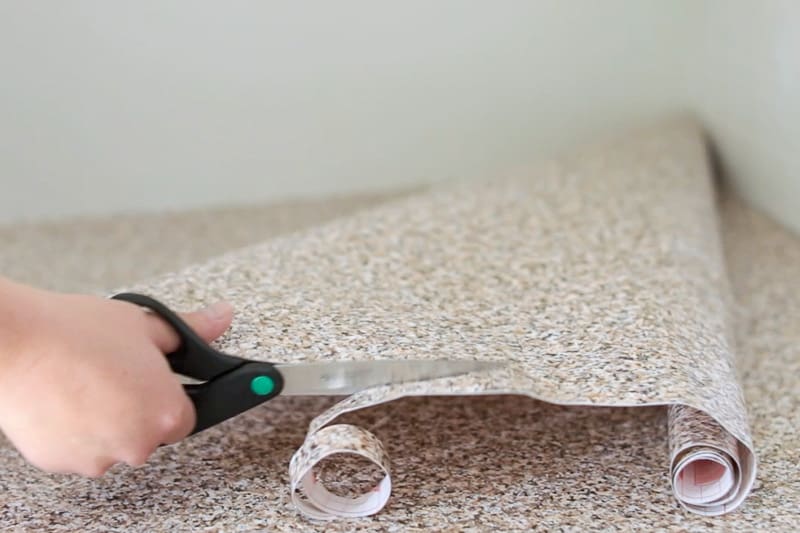
Then line up the straight edge with the backsplash, and press it into place. This back corner will be covered up with small appliances anyway, so the seam will be hidden.
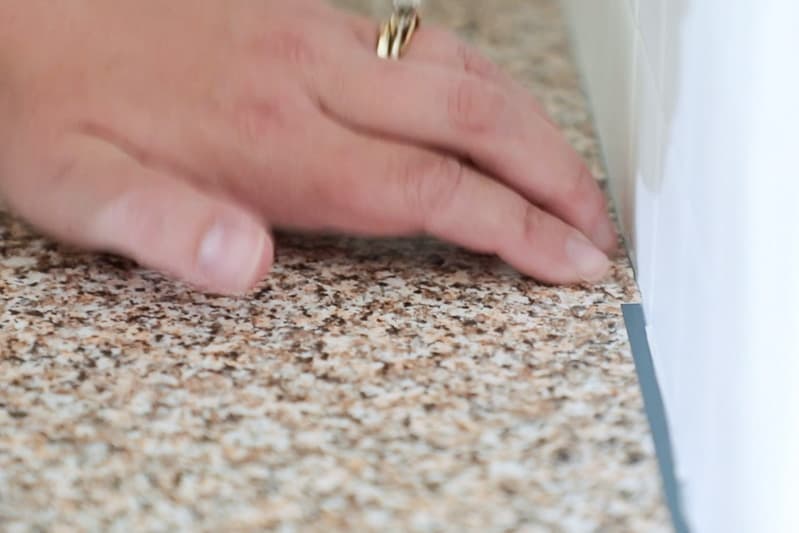
Wrap the corners
Start by wrapping the contact paper around the straight edges of the countertop until it sticks to the lip underneath. Sometimes it doesn't adhere very well to the plywood base, but you can use hot glue or super glue to hold it in place.
You can tackle the corners two different ways. I just folded the two adjoining sides together, like when you're wrapping a present. Then I cut along the vertical corner with a utility knife to remove the fold. You might have a little gap like this, but that's ok!
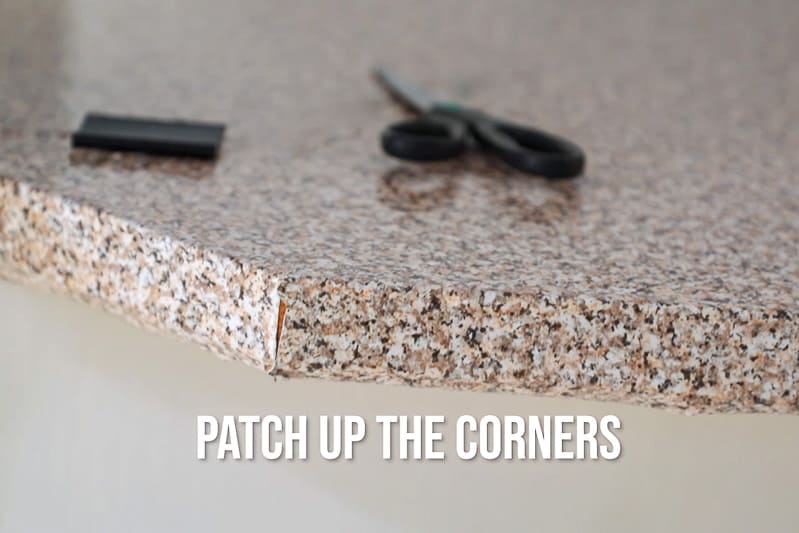
Just cut a small patch three to four inches long and the same thickness as your countertop. Wrap the corner with the patch to reinforce the seam and hide the gap.
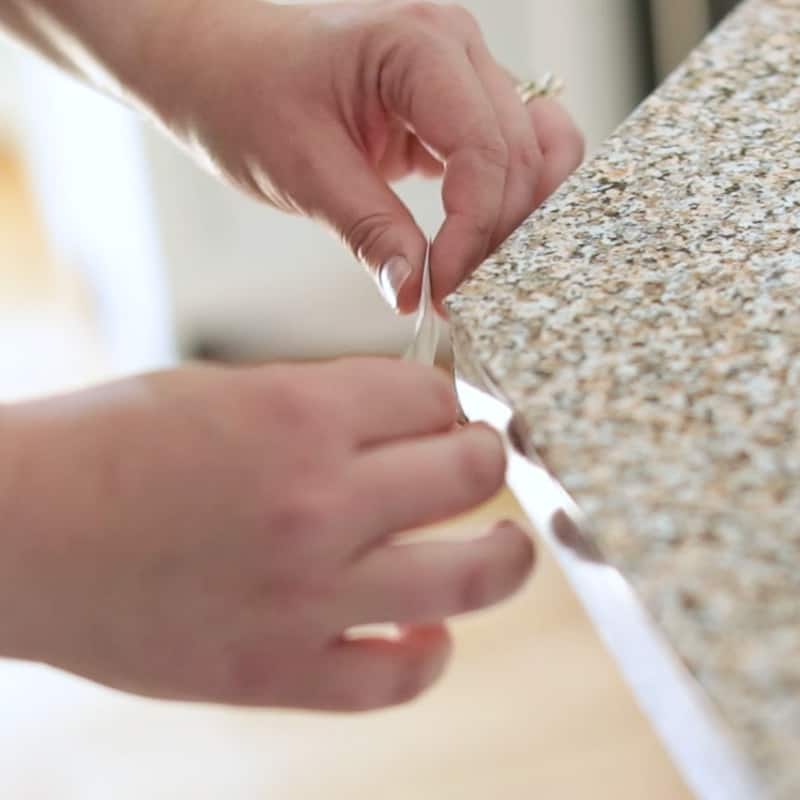
You can just barely see the seams of the patch, because the pattern of the granite helps it blend in.
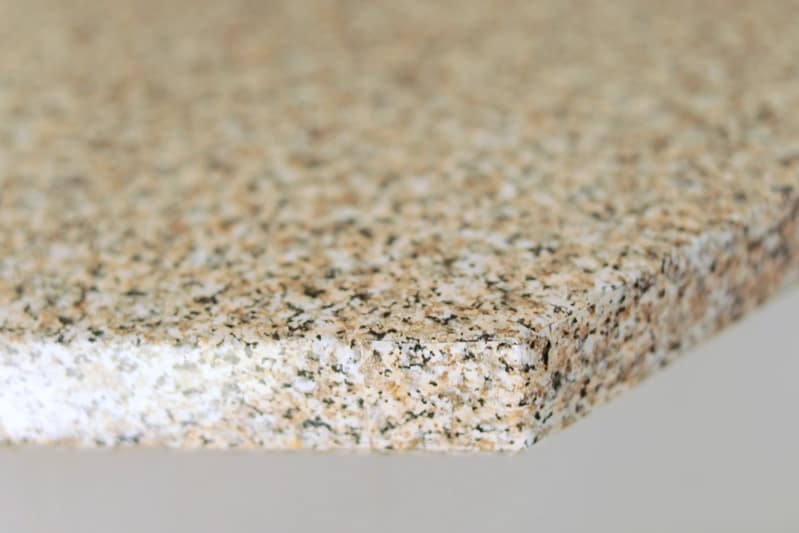
If you have a solid color or marble contact paper, a patch like this might stand out and look too obvious. In this case, you can use a hair dryer to soften the contact paper, then stretch it over the corner. You can see this technique in action in the video here.
Seal seams with silicone caulk (optional)
If you're concerned about water and gunk getting underneath the edges of the contact paper in high traffic areas like the sink or stove, you can seal it with silicone caulk. You can learn more about how to use a caulk gun here.
Keep in mind that this will make it more difficult to remove later, and I didn't find it necessary. You also don't need to apply a top coat or any other sealant on top. It's waterproof all on its own!
I know you're dying to know what it looks like underneath, right? Contact paper kitchen counters are a great solution for renters or military families in government housing who can't change the countertop. But if there's a sticky mess underneath, it might not be worth risking the security deposit.
Let me assure you that this particular brand of countertop contact paper does not leave any residue behind! Here's what ours looks like underneath after two years.
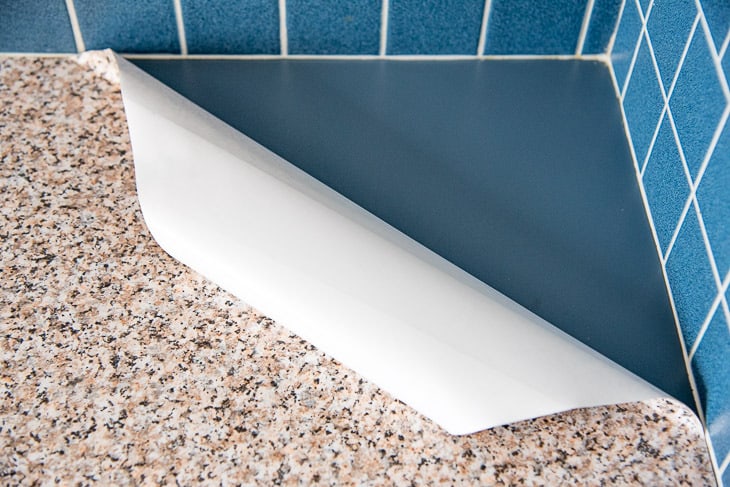
The original laminate is not sticky at all! It looks and feels exactly like it did the day I covered it up. The contact paper peeled up in one big piece, so I didn't have to scrape off any stubborn slivers.
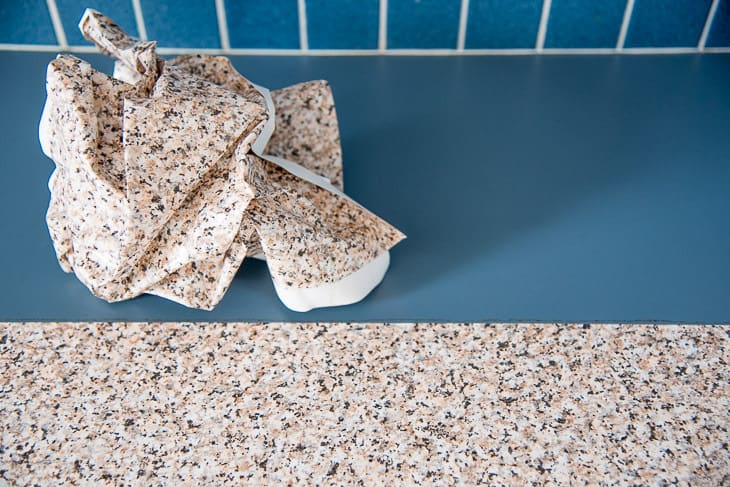
If you look closely, you can see a thin line of grime where the two sheets met. It cleaned up easily with soap and water, leaving the laminate spotless!
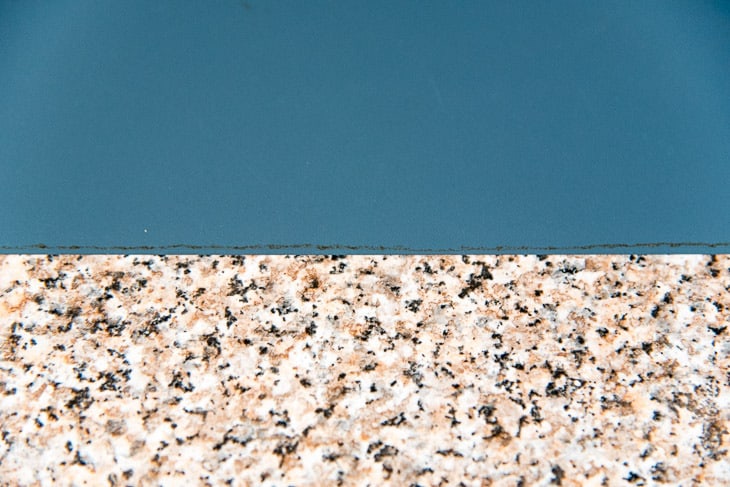
If you applied caulk along the edges, you'll need to break that seal with a utility knife first. Other brands of contact paper may harder to remove, but you can use a hair dryer to soften the adhesive as you peel it away.
Easy peasy, right? If a full kitchen or bathroom makeover isn't in the budget, give this quick fix a try.
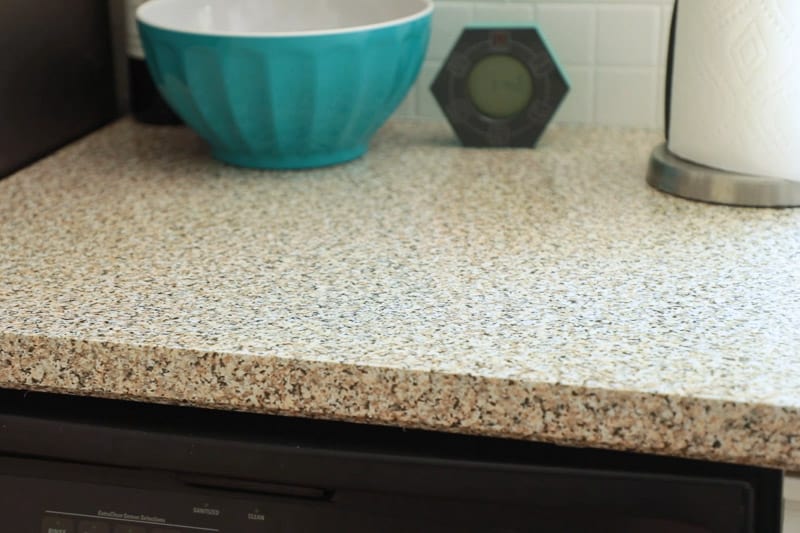
Check out these other kitchen update ideas!
Source: https://www.thehandymansdaughter.com/contact-paper-kitchen-counter/
0 Response to "Tape for Countertop Sides to Make Refrigerator Moving Sliding Easy"
Post a Comment